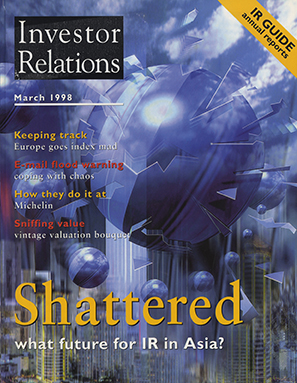‘Asia seemed to be just gearing up for a push on to a higher level of investor relations. Then the markets started collapsing.’ That was the ominous introduction to Richard Carpenter’s March 1998 cover story, simply titled: Shattered.
|
IR Magazine March 1998: Shattered |
Writing after the 1997 crash had decimated currencies across South East Asia and Japan and ‘brace yourselves for a difficult year ahead’ was the prevailing mood, many predicted that the region’s steps into investor relations would largely be abandoned because, quite simply, no one wanted to buy the stock.
It wasn’t quite all doom and gloom, however. Andrew Pirie, then a director at financial PR firm Baldwin Boyle Shand in Singapore, had hope for the future. ‘Companies will no longer have access to cheap debt funding, which has been the cause of much of Asia’s problems, so equity funding will become more important,’ he predicted. ‘After stamping out of the region last year, international investors are coming back.’
He also predicted a new drive toward transparency and disclosure – something regulators had already begun the year before but that would surely get a kick in the right direction following the crash.
That drive has continued, with Japan launching its stewardship and corporate governance codes in recent years and China tightening regulations on the asset management industry more recently.
Not all new rules are seen as positive for shareholder rights, however. In May this year Hong Kong Exchanges & Clearing approved new rules to allow companies with dual-class shares to list in the city, while also making it easier for Greater China and international companies to seek a secondary listing and paving the way for ‘pre-revenue’ biotech firms to go public in Hong Kong.
And what of Asian IR? Research by IR Magazine shows that compared with peers in the West, the region’s IR teams tend to have lower budgets and smaller headcounts. Asian senior management members are also the least likely to be the public face of the company at investor meetings – though the CEO, CFO and other senior managers often make up for this with behind-the-scenes work, dedicating a higher number of days to IR than those in North America or Europe.
But perhaps it is these resource constraints, coupled with the region’s ease with technology, that has resulted in a number of interesting IR innovations – such as the widespread use of WeChat for IR or PTTEP’s investor chat room.
There are also numerous Asian IR success stories, including SingTel, which has taken home a massive 42 IR Magazine Awards since 2006.
Even back in March 1998, the Singapore-headquartered telecoms giant was a positive voice among the gloom. ‘I don’t think this trend will go away very quickly,’ Karena Tay, then IRO at SingTel, told IR Magazine at the time. ‘The general consensus is that our results shouldn’t be too badly affected. We’re a defensive stock. The general downturn might lead to a downturn generally in telecommunication businesses but that’s true for all telcos, not just SingTel. So far we haven’t seen any deterioration in performance. Singapore remains relatively strong because our fundamentals are strong.’
As IR Magazine builds up to its 30th anniversary issue – the upcoming winter 2018 issue, which will be the 279th edition of the industry’s flagship magazine – we’ll be posting throwbacks to old covers, revisiting some of the hot topics from the past 30 years of investor relations and hearing from some of the industry titans.
You can look back over old covers and keep track of all things 30th anniversary at our dedicated hub.











